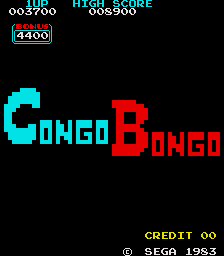Congo Bongo
| Congo Bongo | |
|---|---|
 | |
| Developer(s) | Sega |
| Publisher(s) | Sega |
| Platform(s) |
Arcade (original) Apple II, Atari 5200, Atari 8-bit, Atari 2600, ColecoVision, Intellivision, TI-99/4A, VIC-20, C64, PC booter, SG-1000 |
| Release date(s) | March 12, 1983 |
| Genre(s) | Isometric platformer |
| Mode(s) | Up to 2 players, alternating turns |
| Cabinet | Upright |
| Arcade system |
Z80 CPU @ 3.072 MHz Z80 CPU @ 2 MHz SN76489 audio @ 4 MHz |
| Display | Raster, standard resolution (Used: 256 x 224 / Vertical) Palette Colors 256 |
Congo Bongo (コンゴボンゴ Kongo Bongo), also known as Tip Top (ティップタップ Tippu Tappu), is an isometric platform arcade game released by Sega in 1983. The player takes the role of a red-nosed safari hunter who tries to catch an ape named Bongo. The hunter seeks Bongo to exact revenge for an apparent practical joke in which Bongo set fire to the hunter's tent, giving him a literal "hotfoot." The game was named by Peter W. Gorrie who was the CFO of Sega at that time.
The game's ROM contains a message indicating it was likely coded at least in part by the company Ikegami Tsushinki.[1][2][3]
Gameplay
Congo Bongo's gameplay is similar that of Donkey Kong and Frogger, but levels are viewed in an isometric perspective, or oblique perspective in some ports. The protagonist has no offensive abilities and must move or jump to avoid enemies and obstacles to complete a level.
Reception
Ahoy! in 1984 stated that Congo Bongo for the Commodore 64 and VIC-20 "is fraught with problems; gameplay is repetitive, frustrating, tedious, inconsistent, and at times confusing, and the music not only got on my nerves but stomped on them. Plus, the whole thing is derivative".[4] In 1984 Softline readers named the game the worst Atari program of 1983.[5]
Ports and legacy

Despite being a commercial failure when it was initially released [6] Congo Bongo has been ported to nearly every major gaming platform of the day, including SG-1000, MSX, Intellivision,[7] ColecoVision, Commodore 64 (twice - by Sega in 1983 and by U.S. Gold in 1985), IBM PC, Atari 2600, Atari 5200, Atari 8-bit computers and the Texas Instruments TI-99 4/A. Sega's ports for the Atari 2600, 5200, 8-bits and the Commodore 64 featured only two of the four levels from the arcade original, while the ColecoVision release is missing the level "Snake Lake." The Intellivision port features all 4 of the game's original levels.
An emulated version of the original arcade release is featured as an unlockable in the PlayStation Portable version of the Sega Genesis Collection (Sega Mega Drive Collection in PAL regions). This version was also featured in Sonic's Ultimate Genesis Collection (Sega Mega Drive Ultimate Collection in PAL regions) for Xbox 360 and PlayStation 3. An enhanced remake was released for the PlayStation 2 under the Sega Ages label as Sega Ages 2500 Vol 23: Sega Memorial Collection.
References
- ↑ Ikegami Tsushinki
- ↑ ドンキーコング裁判についてちょこっと考えてみる Thinking a bit about Donkey Kong, accessed 2009-02-01
- ↑ It started from Pong (それは『ポン』から始まった : アーケードTVゲームの成り立ち sore wa pon kara hajimatta: ākēdo terebi gēmu no naritachi), Masumi Akagi (赤木真澄 Akagi Masumi), Amusement Tsūshinsha (アミューズメント通信社 Amyūzumento Tsūshinsha), 2005, ISBN 4-9902512-0-2.
- ↑ Hallassey, Dan (March 1984). "Congo Bongo". Ahoy!. p. 60. Retrieved 27 June 2014.
- ↑ "The Best and the Rest". St.Game. Mar–Apr 1984. p. 49. Retrieved 28 July 2014.
- ↑ According to "Video Games Go Crunch!" in TIME magazine October 17, 1983 issue, Congo Bongo was a commercial failure initially,
- ↑ Intellivision Rarity Guide
External links
- Congo Bongo at the Killer List of Videogames
- The MS-DOS version of Congo Bongo can be played for free in the browser at the Internet Archive
- Congo Bongo at Phosphor Dot Fossils